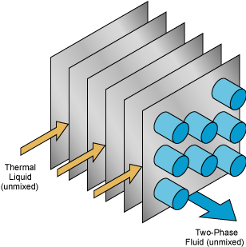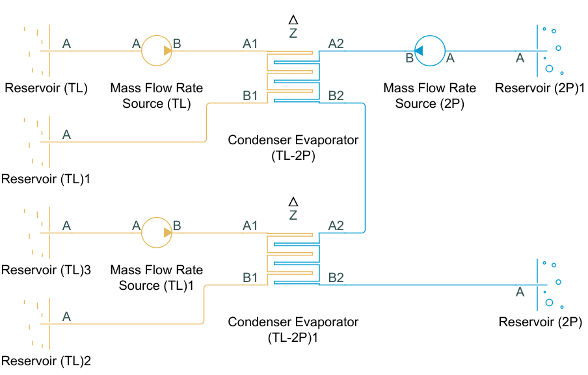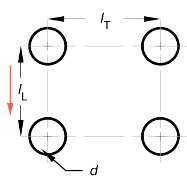Condenser Evaporator (TL-2P)
Models heat exchange between a thermal liquid network and two-phase fluid network
Libraries:
Simscape /
Fluids /
Heat Exchangers /
Two-Phase Fluid - Thermal Liquid
Description
The Condenser Evaporator (TL-2P) block models a heat exchanger with one thermal liquid network, which flows between ports A1 and B1, and one two-phase fluid network, which flows between ports A2 and B2. The heat exchanger can act as a condenser or as an evaporator. The fluid streams can be aligned in parallel, counter, or cross-flow configurations.
Example Heat Exchanger for Refrigeration Applications

You can model the thermal liquid side as flow within tubes, flow around the two-phase fluid tubing, or by an empirical, generic parameterization.
The block uses the Effectiveness-NTU (E-NTU) method to model heat transfer through the shared wall. Fouling on the exchanger walls, which increases thermal resistance and reduces the heat exchange between the two fluids, is also modeled. You can also optionally model fins on both the thermal liquid and two-phase fluid sides. Pressure loss due to viscous friction on both sides of the exchanger can be modeled analytically or by generic parameterization, which you can use to tune to your own data.
You can model the two-phase fluid side as flow within a tube or a set of tubes. The two-phase fluid tubes use a boundary-following model to track the sub-cooled liquid (L), vapor-liquid mixture (M), and super-heated vapor (V) in three zones. The relative amount of space a zone occupies in the system is called a zone length fraction within the system.
Zone Length Fractions in the Two-Phase Fluid Piping

The sum of the zone length fractions in the two-phase fluid tubing equals
1. Port Z returns the zone
length fractions as a vector of physical signals for each of the three phases: [L, M,
V].
Heat Exchanger Configuration
The heat exchanger effectiveness is based on the selected heat exchanger configuration, the fluid properties in each phase, the tube geometry and flow configuration on each side of the exchanger, and the usage and size of fins.
The Flow arrangement parameter assigns the relative flow paths between the two sides:
Parallel flowindicates the fluids are moving in the same direction.Counter flowindicates the fluids are moving in parallel, but opposite directions.Cross flowindicates the fluids are moving perpendicular to each other.
When Flow arrangement is set to Cross
flow, use the Cross flow arrangement
parameter to indicate whether the two-phase fluid or thermal liquid flows are
separated into multiple paths by baffles or walls. Without these separations,
the flow can mix freely and is considered mixed. Both
fluids, one fluid, or neither fluid can be mixed in the cross-flow arrangement.
Mixing homogenizes the fluid temperature along the direction of flow of the
second fluid, and varies perpendicular to the second fluid flow.
Unmixed flows vary in temperature both along and perpendicular to the flow path of the second fluid.
Sample Cross-Flow Configurations



Note that the flow direction during simulation does not impact the selected flow arrangement setting. The ports on the block do not reflect the physical positions of the ports in the physical heat exchange system.
All flow arrangements are single-pass, which means that the fluids do not make multiple turns in the exchanger for additional points of heat transfer. To model a multi-pass heat exchanger, you can arrange multiple Condenser Evaporator (TL-2P) blocks in series or in parallel.
For example, to achieve a two-pass configuration on the two-phase fluid side and a single-pass configuration on the thermal liquid side, you can connect the two-phase fluid sides in series and the thermal liquid sides to the same input in parallel (such as two Mass Flow Rate Source blocks with half of the total mass flow rate), as shown below.

The Flow geometry parameter sets the thermal liquid flow arrangement as either inside a tube or set of tubes, or perpendicular to a tube bank. You can also specify an empirical, generic configuration. The two-phase fluid always flows inside a tube or set of tubes.
When Flow geometry is set to Flow
perpendicular to bank of circular tubes, use the
Tube bank grid arrangement parameter to define the
two-phase fluid tube bank alignment as either Inline
or Staggered. The red, downward-pointing arrow
indicates the direction of thermal liquid flow. The Inline figure also shows the
Number of tube rows along flow direction and the
Number of tube segments in each tube row parameters.
Here, flow direction refers to the thermal liquid flow, and
tube refers to the two-phase fluid tubing. The
Length of each tube segment in a tube row parameter is
indicated in the Staggered figure.


The heat exchanger configuration does not have fins when the Total
fin surface area parameter is 0 m^2. Fins
introduce additional surface area for heat transfer. Each fluid side has a
separate fin area and parameters that describe the fins in that fluid. For
example, when the thermal liquid flows inside the tubes and the two-phase fluid
flows outside of the tubes, the Total fin surface area and
Fin efficiency parameters in the Thermal
Liquid 1 section describe the fins protruding into the tube. The
Total fin surface area and Fin
efficiency parameters in the Two-Phase Fluid
2 section describe the fins outside of the tubes.
Effectiveness-NTU Heat Transfer
The heat transfer rate is calculated for each fluid phase. In accordance with the three fluid zones that occur on the two-phase fluid side of the heat exchanger, the heat transfer rate is calculated in three sections.
The convective heat transfer in a zone is
where:
CMin is the lesser of the heat capacity rates of the two fluids in that zone. The heat capacity rate is the product of the fluid specific heat, cp, and the fluid mass flow rate. CMin is always positive.
TIn,2P is the zone inlet temperature of the two-phase fluid.
TIn,TL is the zone inlet temperature of the thermal liquid.
ε is the heat exchanger effectiveness.
Effectiveness is a function of the heat capacity rate and the number of transfer units, NTU, and also varies based on the heat exchanger flow arrangement, which is discussed in more detail in Effectiveness by Flow Arrangement. The NTU is calculated as:
where:
z is the individual zone length fraction.
R is the total thermal resistance between the two flows, due to convection, conduction, and any fouling on the tube walls:
where:
U is the convective heat transfer coefficient of the respective fluid. This coefficient is discussed in more detail in Two-Phase Fluid Correlations and Thermal Liquid Correlations.
F is the Fouling factor on the two-phase fluid or thermal liquid side, respectively.
RW is the Thermal resistance through heat transfer surface.
ATh is the heat transfer surface area of the respective side of the exchanger. ATh is the sum of the wall surface area, AW, and the Total fin surface area, AF:
where ηF is the Fin efficiency.
The total convective heat transfer rate between the fluids is the sum of the heat transferred in the three zones by the subcooled liquid (QL), liquid-vapor mixture (QM), and superheated vapor (QV):
The fluid properties that the block uses in heat transfer calculations are the average between the value at the inlet and the value in the fluid volume.
The heat exchanger effectiveness varies according to its flow configuration and the mixing in each fluid. Below are the formulations for effectiveness calculated in the liquid and vapor zones for each configuration. The effectiveness is for all configurations in the mixture zone.
When Flow arrangement is set to
Parallel flow:When Flow arrangement is set to
Counter flow:When Flow arrangement is set to
Cross flowand Cross flow arrangement is set toBoth fluids unmixed:When Flow arrangement is set to
Cross flowand Cross flow arrangement is set toBoth fluids mixed:
When one fluid is mixed and the other unmixed, the equation for
effectiveness depends on the relative heat capacity rates of the fluids.
When Flow arrangement is set to Cross
flow and Cross flow arrangement
is set to either Thermal Liquid 1 mixed & Two-Phase
Fluid 2 unmixed or Thermal Liquid 1
unmixed & Two-Phase Fluid 2 mixed:
When the fluid with Cmax is mixed and the fluid with Cmin is unmixed:
When the fluid with Cmin is mixed and the fluid with Cmax is unmixed:
CR denotes the ratio between the heat capacity rates of the two fluids:
Conductive Heat Transfer
The conductive heat transfer in a zone is
where:
Tout,2P is the zone outlet temperature of the two-phase fluid.
Tout,TL is the zone outlet temperature of the thermal liquid.
Rcond is the total conductive thermal resistance between the two flows,
where:
AW is the wall surface area.
k is the thermal conductivity of each fluid.
DH is the hydraulic diameter.
The total heat transfer is the sum of the convective and conductive heat transfer. The conductive heat transfer is negligible compared to the convective heat transfer. When the flow rate is zero, the convective heat transfer is also zero. However, because heat transfer from convection and conduction operate independently of each other, there is still conductive heat transfer even when the convective heat transfer is zero.
Two-Phase Fluid Correlations
The convective heat transfer coefficient varies according to the fluid Nusselt number:
where:
Nu is the zone mean Nusselt number, which depends on the flow regime.
k is the fluid phase thermal conductivity.
DH is tube hydraulic diameter.
For turbulent flows in the subcooled liquid or superheated vapor zones, the Nusselt number is calculated with the Gnielinski correlation:
where:
Re is the fluid Reynolds number.
Pr is the fluid Prandtl number.
For turbulent flows in the liquid-vapor mixture zone, the Nusselt number is calculated with the Cavallini-Zecchin correlation:
where:
ReSL is the Reynolds number of the saturated liquid.
PrSL is the Prandtl number of the saturated liquid.
ρSL is the density of the saturated liquid.
ρSV is the density of the saturated vapor.
a= 0.05, b = 0.8, and c= 0.33.
For laminar flows, the Nusselt number is set by the Laminar flow Nusselt number parameter.
For transitional flows, the Nusselt number is a blend between the laminar and turbulent Nusselt numbers.
When the Heat transfer coefficient model parameter is set
to Colburn equation, the Nusselt number for the
subcooled liquid and superheated vapor zones is calculated by the empirical the
Colburn equation:
where a, b, and c are defined in the Coefficients [a, b, c] for a*Re^b*Pr^c in liquid zone and Coefficients [a, b, c] for a*Re^b*Pr^c in vapor zone parameters.
The Nusselt number for liquid-vapor mixture zones is calculated with the Cavallini-Zecchin equation, with the coefficients specified in the Coefficients [a, b, c] for a*Re^b*Pr^c in mixture zone parameter.
The pressure loss due to viscous friction varies depending on flow regime and
configuration. The pressure loss calculation uses the overall density, which is
the total fluid mass divided by the total fluid volume. When the
Pressure loss model parameter is
Correlation for flow inside tubes, the pressure
loss due to friction depends on the Darcy friction factor.
For turbulent flows, when the Reynolds number is above the Turbulent flow lower Reynolds number limit parameter, the block calculates the pressure loss due to friction in terms of a calculated Darcy friction factor. The pressure differential between port A1 and the internal node I1 is:
where:
A1 is the total flow rate through port A1.
fD,A is the Darcy friction factor according to the Haaland correlation. When the Local resistance specification parameter is
Aggregate equivalent length,where εR is the value of the Internal surface absolute roughness parameter. The friction factor is dependent on the Reynolds number, and the block calculates this value at both ports for each liquid.
L is the value of the Total length of each tube parameter.
LAdd is the value of the Aggregate equivalent length of local resistances parameter, which is the equivalent length of a tube that introduces the same amount of loss as the sum of the losses due to other local resistances in the tube.
ACS is the tube cross-sectional area.
The pressure differential between port B1 and internal node I1 is:
where B1 is the total flow rate through port B1.
When the Local resistance specification parameter is
Aggregate equivalent length, the Darcy friction
factor at port B1 is:
When the Local resistance specification parameter is
Local loss coefficient, the Darcy friction
factors at ports A1 and B1 are
where Clocalloss is the value of the Total local loss coefficient parameter.
For laminar flows, when the Reynolds number is below the Laminar
flow upper Reynolds number limit parameter, the block calculates
the pressure loss due to friction in terms of the Laminar friction
constant for Darcy friction factor parameter,
λ. λ is a user-defined parameter when
Tube cross-section is
Generic. Otherwise, the block calculates the
value internally. The pressure differential between port A1
and internal node I1 is:
where μ is the fluid dynamic viscosity. The pressure differential between port B1 and internal node I1 is:
For transitional flows, the pressure differential due to viscous friction is a smoothed blend between the values for laminar and turbulent pressure losses.
When Pressure loss model is set to Pressure
loss coefficient, the pressure losses due to viscous friction
are calculated with an empirical pressure loss coefficient,
ξ.
The pressure differential between port A2 and internal node I2 is:
The pressure differential between port B2 and internal node I2 is:
Thermal Liquid Correlations
When the thermal liquid Flow geometry is set to
Flow inside one or more tubes, the Nusselt number
is calculated according to the Gnielinski correlation in the same manner as
two-phase subcooled liquid or superheated vapor. See Heat Transfer Coefficient for more
information.
When the thermal liquid Flow geometry is set to
Flow perpendicular to bank of circular tubes, the
Nusselt number is calculated based on the Hagen number, Hg, and depends on the
Tube bank grid arrangement setting:
where:
D is the Tube outer diameter.
lL is the Longitudinal tube pitch (along flow direction), the distance between the tube centers along the flow direction. Flow direction refers to the thermal liquid flow.
lT is the Transverse tube pitch (perpendicular to flow direction), shown in the figure below. The transverse pitch is the distance between the centers of the two-phase fluid tubing in one row.
lD is the diagonal tube spacing, calculated as
For more information on calculating the Hagen number, see [3].
The longitudinal and transverse pitch distances are the same for both grid bank arrangement types.
Cross-Section of Two-Phase Fluid Tubing with Pitch Measurements


When the Heat transfer coefficient model is set to
Colburn equation or when Flow
geometry is set to Generic, the
Nusselt number is calculated by the empirical the Colburn equation:
where a, b, and c are the values defined in the Coefficients [a, b, c] for a*Re^b*Pr^c parameter.
When the thermal liquid Flow geometry parameter is
Flow inside one or more tubes, the pressure loss
is calculated the same way as for two-phase flows, with the respective Darcy
friction factor, density, mass flow rates, and pipe lengths of the thermal
liquid side. See Pressure Loss for more
information.
When the thermal liquid Flow geometry is set to
Flow perpendicular to bank of circular tubes, the
Hagen number is used to calculate the pressure loss due to viscous friction. The
pressure differential between port A1 and internal node I1 is:
where:
μTL is the fluid dynamic viscosity.
NR is the Number of tube rows along flow direction. This is the number of two-phase fluid tube rows along the thermal liquid flow direction.
The pressure differential between port B1 and internal node I1 is:
When the Pressure loss model parameter is
Euler number per tube row or when the
Flow geometry parameter is
Generic, the pressure loss due to viscous
friction is calculated with a pressure loss coefficient, in terms of the Euler
number, Eu:
where ξ is the empirical pressure loss coefficient.
The pressure differential between port A1 and internal node I1 is:
The pressure differential between port B1 and internal node I1 is:
Wall Thermal Mass
If you select Enable wall thermal mass, the block models the heat exchanger wall thermal mass, which introduces a delay in the wall's transient response to changes in temperature or heat flux. If you model thermal mass, the wall stores heat in its bounds. This heat storage slows the transition between steady states so that a thermal perturbation on one side does not immediately manifest on the other side. The lag persists until the heat flow rates from the two sides balance.
If you select Enable wall thermal mass, the wall energy conservation is
where:
Mwall is the value of the Wall mass parameter.
cp,wall is the value of the Wall specific heat parameter.
Twall is the effective wall temperature on each side. The block uses this value to model the transient response. You cannot measure this value.
The heat transfer to each fluid is
where:
Tin is the fluid inlet temperature on each side.
C is the heat capacity rate for each fluid.
The number of heat transfer units between the fluid and the wall on each side is
where A is the wall surface area and U is the heat transfer coefficient.
Conservation Equations
The total mass accumulation rate in the two-phase fluid is defined as:
where:
M2P is the total mass of the two-phase fluid.
A2 is the mass flow rate of the fluid at port A2.
B2 is the mass flow rate of the fluid at port B2.
The flow is positive when flowing into the block through the port.
The energy conservation equation relates the change in specific internal energy to the heat transfer by the fluid:
where:
u2P is the two-phase fluid specific internal energy.
φA1 is the energy flow rate at port A1.
φB1 is the energy flow rate at port B1.
Q is heat transfer rate, which is positive when leaving the two-phase fluid volume.
The total mass accumulation rate in the thermal liquid is defined as:
The energy conservation equation is:
where:
ϕA1 is the energy flow rate at port A1.
ϕB1 is the energy flow rate at port B1.
The heat transferred to or from the thermal liquid, Q, is equal to the heat transferred from or to the two-phase fluid.
Examples
Ports
Conserving
Output
Parameters
References
[1] 2013 ASHRAE Handbook - Fundamentals. American Society of Heating, Refrigerating and Air-Conditioning Engineers, Inc., 2013.
[2] Cengel, Yunus A. Heat and Mass Transfer: A Practical Approach. 3rd ed, McGraw-Hill, 2007.
[3] Shah, R. K., and Dusan P. Sekulic. Fundamentals of Heat Exchanger Design. John Wiley & Sons, 2003.
[4] White, Frank M. Fluid Mechanics. 6th ed, McGraw-Hill, 2009.

